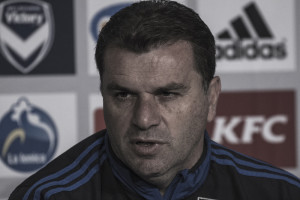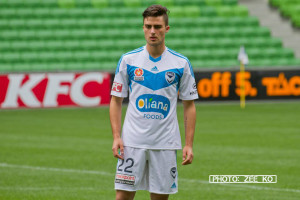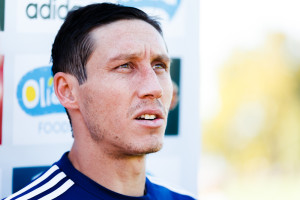For Melbourne Victory fans, this was meant to be their season. The Kewell and Durakovic era had become distant memory as Ange Postecoglou’s tenure was well and truly set in motion, with his first campaign ending just short of a grand final appearance. In one season, he turned a dysfunctional unit into a well-oiled machine. But before the club could fully reap the rewards, Frank Lowy dangled the Socceroos carrot in front of Postecoglou, and the latter answered the call.

Kevin Muscat seemed the logical choice to pass the baton onto, having been Melbourne’s assistant coach for many years. But as Rado Vidosic experienced at Brisbane before him, taking over the system Postecoglou developed while adding a personal touch on the team was a difficult task. The early weeks saw reasonable results, before consecutive 5-0 losses to Wellington and Sydney cast shadows over Muscat’s capacity for the role, and suddenly a talented squad was branded as a bunch of underachievers.
With the Asian Champions League just around the corner, Victory managed to sneak through its qualifying game against Muanthong United, only to join the Group of Death, consisting of reigning champions Guangzhou Evergrande, Korea’s richest club Jeonbuk Hyundai Motors, and Yokohama F. Marinos, runners up in last season’s J-League. Already struggling to find form and consistency, how would an erratic and further depleted Victory cope with a fixture of 14 games in 60 days, clocking up 60,000 kilometres of travel and playing against the Asian powerhouses?
Historically, the ACL had been deemed an annoying blip on Melbourne Victory’s radar, given little priority and opportunity to progress. The writing was on the wall again this year, with many pundits bracing for heavy defeats. Yet there was something in the murky Yarra River waters this year, leading to a change in approach, and importantly a positive attitude towards Asia’s premier club competition.The 2-0 lead against Guangzhou in the opening round was unprecedented, and while normal service resumed in the second half to end 4-2 in favour of the defending champions, a certain belief was instilled in the players that they could take it to the best teams in Asia. In five games, Victory scored first each time with mixed results, but had gradually improved at holding a lead, culminating in a return fixture triumph over Asia’s biggest club, 2-0. In heartbreaking fashion, a contentious 0-0 draw against Jeonbuk saw Victory just miss out on progression through goal difference.
Ultimately, the six extra games on Victory’s calendar seemed to galvanise the squad, giving fringe players a run and offering the whole squad (bar Finkler) an opportunity to prove themselves against the best sides in Asia. Pleasingly, the players grasped their opportunity with both hands, with captain Mark Milligan of the belief that if it weren’t for the Champions League, that opportunity may not have come at all.
“Being realistic, there is not that many games in the A-League and you can go through a year where a lot of the young boys or the new players don’t really get a chance, and the Champions League has really given our young boys a chance to come in a and get some game time and to be fair they’ve done extremely well. They’ve done very, very good so that experience that they’ve gained over the last.”

Jesse Makarounas, arriving mid last season from Perth Glory with a reputation as a promising youngster, would have been frustrated with his lack of game time at Victory so far. Filling in for Gui Finkler, the unlucky foreigner omitted from the squad, Makarounas has proved to be an astute attacking midfielder, and would surely be on the verge of breaking into Muscat’s first team plans next season. Likewise, James Jeggo, after many years on Victory’s books, finally found his way back into the starting XI since the Magilton days, proving himself a reliable box-to-box midfielder with an impressive passing range. If the rumours are true that he is leaving for Adelaide next season, perhaps Victory were too late to realise they had a diamond in the rough.
On the defensive side, Dylan Murnane, understudy to Adama Traore in the left-back position, has been serviceable when called upon. Nick Ansell, also second choice to Adrian Leijer and marquee Pablo Contreras at season’s start, has continued his impressive development from last season.The added game time has also allowed Scott Galloway and Jason Geria to rotate the right-back spot, both benefiting their games.
On the wing, Connor Pain and Andrew Nabbout both got a chance to impress, though the former has especially struggled to cope. However, the exposure to Asia’s strongest teams has now shown him the standard he should aspire to meet and succeed, and the onus is on him to work hard to achieve that success.

In terms of Socceroo selection, the lure of potential Champions League football got Tom Rogic’s loan deal over the line. He was getting the game time he required until becoming sidetracked by injury. Mark Milligan has all but cemented a starting berth in Ange’s XI with the additional playing time. Then there’s James Troisi, the dark horse who seemingly struggled early in Muscat’s tenure after Postecoglou’s departure, has since flourished and is almost a shoe-in for a World Cup spot, looking sharp and racking up goals and assists along the way.
Heck, even the stronger competition seems to have brought out the best in enigmatic defender Pablo Contreras.
Importantly, the experience also benefited Kevin Muscat’s development as a coach, forcing him to adapt to different situations and game styles, and rotate and motivate his players accordingly. Importantly, he was able to shore up his team’s defence, which kept three clean sheets throughout the campaign, impressive considering they still haven’t been able to emulate these efforts in the A-League since round 10. Naturally, there were bumps along the way. The 4-0 defeat to Melbourne Heart was perhaps the lowest point, the best indication of a team beginning to buckle under the workload, and there were subsequent A-league games where, in seeking to tighten up defensively, Victory lost potency going forward, unable to find appropriate space or fluidity to attack.
Overall, Victory was one of a trio of A-League clubs to perform admirably in the ACL this season, relative to historical performances. Though only Western Sydney progressed to the next round, the interest and monitoring of this year’s Australian participants, right until the final group games, was unlike most years, and went some way to appease the critics who questioned the standard of quality of this season’s A-League. Hopefully, this will act as a coming of age for A-league clubs in Asia and a springboard for administrators, media and fans to show more interest towards the competition. Success breeds success.
Club owners have often baulked at the costs of participating in the ACL, but exposure of their club and its brand to an audience of tens of millions can’t be a bad thing. It may be simplistic thinking, but the improved performances can increasingly attract sponsors willing to showcase their brand to our regional neighbours. With more money in the game, the ultimate aim would be to revise and increase the salary cap, giving A-League teams even greater chances to compete with, and succeed against, the best teams in Asia. On an added note, that all three ACL clubs have finished in the A-League semi finals proves the workload is manageable, though it may also say more about the farcical performances of the clubs below them.
Importantly for fans, it’s at least six extra games to engage with, follow with friends, and discuss in large circles on social media. 27 A-League games a season is little compared to most other global leagues, and with the long Australian off-season, fans of Australian football are often starved of action. The FFA cup will go some way to eradicating this gap and connecting audiences with grassroots, along with the Champions League which will help expose fans to the Asian game, both which have been desperately lacking in Australia, judging by crowd numbers.
Unfortunately, the competition still doesn’t have enough traction in mainstream media. Little news was made of the historic day when Melbourne Victory and Western Sydney defeated Guangzhou and Ulsan Hyundai 2-0 respectively. Other than the work of dedicated football journalists in Australia, the competition receives little coverage in the big media outlets. It deserves to have its own time in the spotlight.
Back to the Melbourne Victory, while they landed just short of progressing to the next round, and succumbed to another semi-final loss in the A-league, upon reflection the 2013-14 season can be viewed as somewhat successful. The coaching staff and players can look back on their foray into the Asian continental competition fondly, albeit a little disappointed on just missing out on the next round, but proud of their efforts considering nobody initially gave them a chance of progressing anyway. Even though Victory had to essentially play four must-win games in a row, and faltered at the end, it should hold Muscat and his players in good stead for next season, where the focus will solely be on the domestic competition again.
What a difference that deflected left footed Leigh Broxham strike down at Kardinia Park made. The competition may still have doubters, but it’s hard to argue that Victory, as well as the Wanderers and Mariners have been better because of it.

